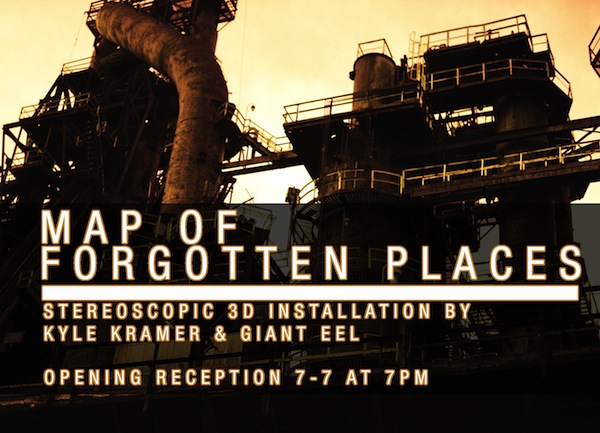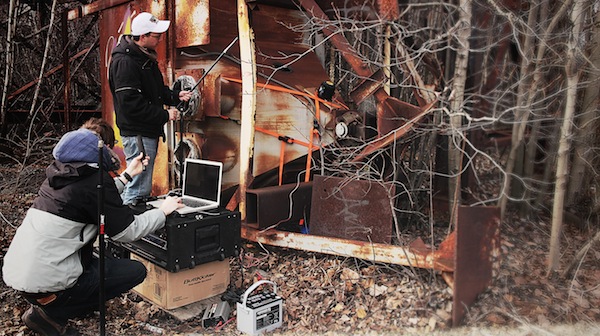
Giant Eel brings stereoscopic 3D media to Detroit
If you haven’t made it to the current show up at StArt Gallery, “Map of Forgotten Places,” do yourself a favor and get there immediately (or at least before July 21, when the show comes down). The work on display is an awe-inspiring technical and aesthetic feat by an upstart collective known as Giant Eel, whose specialty is stereoscopic 3D media. The gallery show features beautifully-textured 3D images of Detroit, as well as a 3D movie shot partly from a radio-controlled helicopter swooping through abandoned warehouses, overlaid with ominous audio recorded on location by Kyle Kramer. Giant Eel already has an impressive track record of accomplishments, with many great things in store for the future. I had the pleasure of speaking with Edmund Zagorin, the CEO of Giant Eel. The result of our conversation is below:
Jeremy Schmall: Can you tell me a little about the history of Giant Eel? How and where did you all meet? Edmund Zagorin: Giant Eel began in late 2010, when my friend Jacob Mendel approached me to help produce his senior thesis in Screen Arts & Cultures at the University of Michigan. He wanted to shoot it in 3D, even though the whole digital 3D thing was very new, and virtually unheard of for student films. Since there was a great deal of learning and tinkering he was putting in to try and solve some of the problems associated with the high costs of 3D, I suggested we start a company that could be a way for us to use these technical innovations to collaborate on different creative projects. He thought about it for a month, and then agreed. Later on, we started working with different artists and engineers, including Kyle Kramer and Kevin Serota. That’s really the point; to use innovative technology to produce novel aesthetic engagements.
JS: Is there a story behind the name of the collective? EZ: Yes, probably several. It’s mostly intended to be playful, or ludic in the sense of Huizinga. I think it’s important that as a group we try not to take ourselves too seriously. There’s nothing like artists acting like their work contains the only self-evident Truth, and then demanding the critic’s high-minded sobriety. If you want to read an actual story, there’s a somewhat adolescent rendering of the meditation on giant eels and the axioms of artistic labor here.
JS: What brings you to Detroit? Is most of your work based out of this city? EZ: Initially, there was something alluring about trying to make video collaborations happen here in Michigan. There was a strong production culture that formed around the time of the tax incentive, and people were very excited about getting involved with different types of work, trying new things. Detroit seemed to be the logical move. It’s a bigger city than Ann Arbor, and it has a lot of amazingly cinematic architecture and interior designs. There’s also a good creative community, especially designers and DIY types. That being said, we will work anywhere there’s an interesting creative project and in the past year have shot everywhere from Los Angeles to rural Arkansas to London.
JS: I think it’s pretty interesting that Giant Eel’s primary focus is 3D stereoscopic images and film. What’s the draw for you into that area? EZ: It’s different for each of us. Jacob has a passion for 3D as a stereographer, to see how he can make an image that really draws you in. It’s like the texture of a space can almost caress your eye, and you feel that little thrill of vertigo created by the optical illusion. When we first started collaborating, Jacob told me that he dreams stereoscopically and I think there’s something very dreamlike about good 3D. For me, 3D is a creative challenge both from a story-telling perspective and in terms of production logistics. You want it to be seamless and immersive, to enhance the willing suspension of disbelief. There are strict rules you have to follow, and that can limit your production options. But it’s like haiku; the rules make it a more interesting challenge. It’s more work, but done right it can be extremely satisfying.
JS: Are there any kind of scenes or photographic/film compositions that you feel particularly lend themselves to 3D? EZ: The short answer is yes, but it’s pretty contextual. Depending on your set-up, you can ruin a 3D composition by having objects that are too close, or shooting in a space that is too confined. That being said, good architecture can make great 3D. That’s part of why we were excited about exploring some of the sites highlighted in “Map of Forgotten Places.” Many of them are the industrial equivalent of cathedrals, and we wanted to use 3D to illuminate their sculptural elements and try to create a sense of awe.
JS: You mentioned that the video in the show is a collaboration, with Kyle Kramer designing both the sound and structuring the relationship between sound and image. The audio we hear sounds strange and eerie; where did it come from? EZ: Kyle Kramer recorded the sounds on location, using an array of contact microphones to listen from the raw materials of each place. The idea is that the audience inhabits each site from the broken-up perspective of the raw materials; the cinderblocks, the metal pipes, the iced-over puddles, each of which represents a distinct element in the multi-channel sound design. You’re literally hearing different objects as if they are placed in different parts of the darkened room around you, and that adds to the immersive experience. In some cases, Kyle used a transducer to create vibrations in the substance he was recording and in other cases the ambient vibrations were more than enough for good audio.
When I screened “Map” at zajia lab in Beijing several weeks ago, one of the discussion participants proposed the notion of ‘peripheral focus’ that made a lot of sense to me. It’s analogy to vision, where we notice our spatial periphery most when our eyes are in focus, yet it arguably holds for cognitive focus, too. In other words, you can think of peripheral focus in terms of the mind’s eye, where vision absorbs your working memory sufficiently for you to really experience the displacement of sound differently than you typically experience ambience. It allows the sound to create suspense and foreboding on its own, in turn giving the work a haunted feel.*
*Kyle Kramer worked on this project as part of his MA thesis for Michigan’s Graduate Program in Media Arts, which deserves thanks for supporting the mapping expedition. Conceptually, Kyle’s focus was precisely this sound/image intermedia relation.
Production photostill showing the contact microphone array and transducer in action. Image courtesy Giant Eel
JS: Also related to the film, how did you get those swooping shots through the abandoned warehouses? EZ: Those shots are actually quite a thrilling technical feat, achieved by Kevin Serota’s 3D aerial videography using a GoPro 3D rig mounted below a custom-built remote-controlled helicopter. It’s essentially a rotor-driven drone, controlled from the nearby ground. The biggest challenge in getting good aerial video is the stability of the shot, especially when it’s windy. Kevin designed and programmed an on-board computer that uses gyroscopic stabilization to keep the copter steady and even to compensate for turbulence, allowing him to pilot some of those nice passing swoops. You can check out more of his aerial video on his YouTube channel. JS: What’s in store for the future of Giant Eel? EZ: There are a variety of projects we’re exploring, some related to drones. Personally, I’d like to work on developing some more theatrical applications using aerial components, now that you can use GPS pretty easily to make drones fly in formation. Think about watching a giant flying puppet show 20-30 feet off the ground! Giant Eel is also initiating a collaboration with the MiND Ensemble‘s Robert Alexander and Anton Pugh to develop visualization applications for consumer-grade brainwave EEGs such as the Emotiv EPOC, with an eye towards direct audience brain-linked interactions. There’s a lot of exciting thinking being done around neuroaesthetics, and we’re excited to play with some fascinating relationships between music, visuality and mind.
“Map of Forgotten Places” is on view until July 21 at StArt Gallery: 206 Grand River Ave., Detroit; 313-909-2845 or [email protected]; startgallery.net
Recent Content
-
Artsarticle ·
-
Artsarticle ·
-
Artsarticle ·


